Key West Declared a Faux War on the United States in 1982
The string of islands ‘seceded’ from the Union and became the Conch Republic
by DARIEN CAVANAUGH
The people of Key West, Florida don’t take kindly to bullies, especiallyfederal bullies. When Washington blocked the only road to the mainland, the islanders formed their own nation … then caused a series of international incidents.
It all started on April 18, 1982, when residents and tourists leaving the Florida Keys ran into an unexpected delay. Without prior notice, the U.S. Border Patrol had set up a roadblock and checkpoint on U.S. Route 1 in front of Skeeter’s Last Chance Saloon in Florida City. It was the only road out of town.
Although they were not crossing a national border, agents required U.S. citizens leaving the Keys to verify their citizenship and submit their vehicles to a search. That’s despite the roadblock not being on an international border.
The roadblock served to prevent undocumented immigrants from entering the U.S. through the Keys. The area had seen an influx of immigrants and refuges from Cuba since the Mariel Boatlift two years earlier. But Border Patrol agents also used the stops to search for illegal drugs.
The delays often lasted several hours, causing traffic to back up for up to 19 miles. It was an inconvenience for residents, but more importantly — it discouraged tourists from visiting the Keys. Tourism is a large source of income to the islanders … and they were losing money daily.
“No one in Key West doubted that drugs were trafficked widely in the Keys by road and by boat” government professor Robert Kerstein wrote in Key West on the Edge — Inventing the Conch Republic. “But tourism’s boosters had little tolerance for interruptions to their business.”

Dennis Wardlow — then Key West’s mayor — acted quickly to address the crisis. He contacted the city’s chief of police, the sheriff of Monroe County, the district’s Florida State representative and Gov. Bob Graham to find out who ordered the roadblock and to demand its removal.
None of them knew who called for the barrier, but they all knew they didn’t have the authority to close it. Wardlow finally contacted the Border Patrol directly. It didn’t go well.
The captain of the Border Patrol told Wardlow the roadblock was “none of his business.”
“Don’t tell a Conch it’s none of your business,” the mayor replied, invoking the nickname of residents of the Keys. The Border Patrol had unwittingly sown the seeds of rebellion.
Wardlow consulted with his city council, business leaders and tourism boosters to discuss the federal agency’s “attack on Key West’s sovereignty.” They decided to seek an injunction from the federal district court in Miami to get the roadblock removed.
On April 22, a small group of Conchs — including Wardlow and local attorney and pilot David Paul Horan — flew to Miami. When Miami’s U.S. District Judge C. Clyde Atkins failed to issue the injunction, he left the citizens of the Keys with little recourse.
“Tomorrow at noon the Florida Keys will secede from the Union!” Wardlow announced to reporters gathered on the courthouse steps on his way out of the building. He and his associates headed home to prepare.
“The first act of rebellion occurred before they had even returned to Key West,” Kerstein wrote. “Horan, a seasoned pilot, buzzed the roadblock on their flight back to the island city.”
Back in Key West, Wardlow and his co-conspirators rapidly organized a new government — albeit a bit tongue-in-cheek. They assigned around 30 officials and civic leaders to new posts such as the secretary of underwater affairs and the minister of nutrition.
“By establishing that border they have declared us a foreign nation,” he told reporters. “We’re tired of the U.S. government picking on little Key West.”
He vowed to negotiate only with Pres. Ronald Reagan or Vice Pres. George H. W. Bush. “I guess they think we’re kidding, and we’re not,” he exclaimed.
Federal agents arrived to monitor the situation. Wardlow, the newly appointed government and a throng of supporters and media gathered at Clinton Square at noon the next day to officially announce the Keys’ secession.
They lowered the Stars and Stripes from the flagpole, and raised the blue and yellow flag of the new Conch Republic. Wardlow read the “Conch Republic Proclamation of Secession.”
“We serve notice to the government in Washington to remove the roadblock or get ready to put up a permanent border to a new foreign land,” he said. “If we’re not equal, we’ll get out. It’s as simple as that … big trouble has started in much smaller places than this.”
Wardlow — now serving as prime minister of the new nation — declared “war” on the United States by breaking a stale loaf of Cuban bread over the head of a man dressed in a U.S. Navy uniform. Citizens of the new republic began lobbing stale bread and conch fritters at federal agents, Navy sailors and Coast Guard personal in attendance.
Approximately one minute after declaring war and firing a “verbal shot” at the U.S., Wardlow surrendered to a nearby naval officer and requested $1 billion in foreign aid to compensate for “the long federal siege.”
The Conch Republic never received any “foreign aid” or war restitution. But the spectacle attracted enough publicity to convince the feds to remove the roadblock. The micro-nation had won.
The idea of the “Conch Republic” became both a source of local pride and a major means of promoting tourism in the Keys. Businesses began selling t-shirts and bumper stickers with the micro-nation’s emblem and slogan — “We Seceded Where Others Failed.”
The Conch Republic’s secretary general even issues “souvenir” passports for citizens and diplomats. The application fee for a passport ranges from $100 to $1,200, depending on status.
“Sir” Peter Anderson — who served as secretary general until his death in 2014 — claimed he had used his diplomatic passport to travel to at least 30 other nations, including Russia. He even claimed to have re-entered the U.S. with it on at least five occasions.
On Oct. 3, 2001, the Miami Herald reported that the Federal Bureau of Investigation was investigating the possibility that Mohammad Atta — one of the 9/11 hijackers — used a Conch Republic passport to enter the U.S. after it learned someone with the same name received such passport in the fall of 2000.
The FBI could never determine for certain if it was the same Atta, but the possibility of someone using the souvenir passports to enter the U.S. may not be as far fetched as it seems.
“A review of Anderson’s Conch Republic passports shows what appear to be five red INS stamps, including a May 29, 1998, stamp at Miami International Airport, three from Key West and a 1994 stamp in San Juan, Puerto Rico,” Herald reporter Jennifer Babson wrote.
By the end of 2000, the Conch Republic had already issued more than 10,000 of the passports.
Today, the U.S. and the Conch Republic enjoy peaceful relations. The tiny faux nation still celebrates the anniversary of its secession with 10 days of parades, parties, fundraisers, a flag raising at Fort Taylor and the Great Conch Republic Drag Race — in which volunteers push female impersonators down Duvall Street in modified shopping carts and buggies.
The tiny republic never officially declared war on the U.S. again, but occasional diplomatic saber rattling and military skirmishes continued.
On Sept. 20, 1995, local radio station WPIK reported that the U.S. Army’s 478th Civil Affairs Battalion planned to conduct a mock invasion and occupation of an island. The Army didn’t notify Key West officials about the operation, and the latter took that failure as an assault on their sovereign nation.
Island officials contacted Pres. Bill Clinton, the U.S. Army and the Navy to advise them that they would oppose the planned “invasion.” The Conch Republic Armed Forces mobilized and a call went out for residents to “defend the nation.”
On Sept. 21, the Conch Republic Navy — a modest fleet of fireboats and private vessels — attacked Navy and Coast Guard ships in Key West Harbor with water hoses, water balloons and volleys of stale Cuban bread and conch fritters.
The attack caught the Naval command off guard, at least from a public relations perspective. The local commander “surrendered” his ships and ordered his men to lay down their arms.
U.S. ground troops attempting to enter the island by bridge met a similar fate, when a force of 200 locals blocked their path and refused to let them pass until they formally requested permission.
The standoff ended peacefully, and the Army sent a letter later that day stating the exercises “in no way meant to challenge or impugn the sovereignty of the Conch Republic.”
Only a few months later, tensions simmered again as a partial shutdown of the federal government led to the closure of Fort Jefferson at Dry Tortugas National Park. The closure of the fort cost the Keys an estimated $30,000 a day in tourism revenue.
After learning that the fort cost only $1,600 a day to operate, city officials and business leaders offered to raise the money to run the park. But they couldn’t get a hold of anyone in the state or federal government who knew how to make that happen.
So an elite Conch air force unit landed at Fort Jefferson to “declare the fort open in the name of the Conch Republic.” They found the park rangers and offered them a check to reopen the fort. The rangers refused, issued the Conchs a citation for trespassing on federal property and told them to leave.
The islanders retreated to Key West, and the feds later dropped the charges.
Relations normalized after 1995, with only a brief flare up when the Conch Republic “annexed” the abandoned Seven Mile Bridge in 2006.
When 15 Cuban refugees landed at the base of the bridge, the Border Patrol and Coast Guard ordered they return to Cuba. They argued that the bridge wasn’t U.S. territory — a precondition as part of the U.S. wet foot, dry foot policy allowing undocumented Cuban immigrants to stay if they make it to American soil.
Anderson led a landing party of Conchs who staked miniature flags along the bridge. “Since the federal government decided in its infinite wisdom that the old Seven Mile Bridge is not territory of the United States, the Conch Republic is very interested,” he told reporters.
The federal government “chose not to defend” the bridge from the Conch invasion. “It could be a model green community,” he said, “with composting toilets, wind and solar power, rainwater collection, like living on a boat, really.”
The islanders still boast a “standing” army, navy and air force. They say it’s just to re-enact battles with U.S. Coast Guard and Navy. But if you’re ever in Key West, watch out for stale Cuban bread.
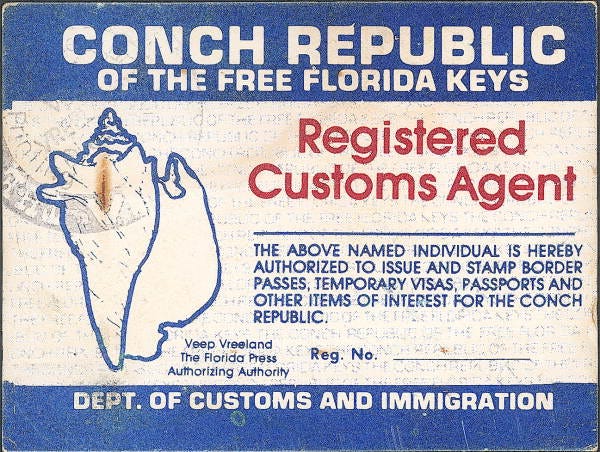
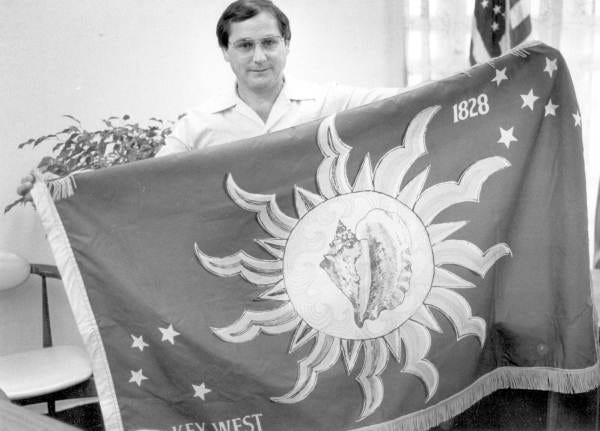
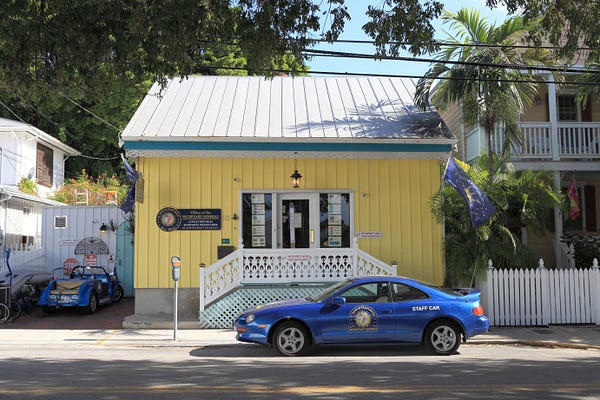
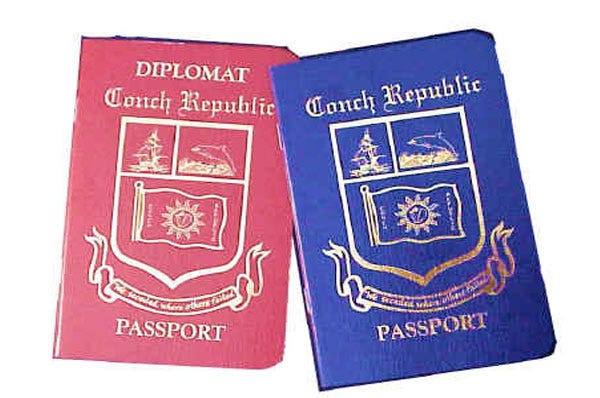
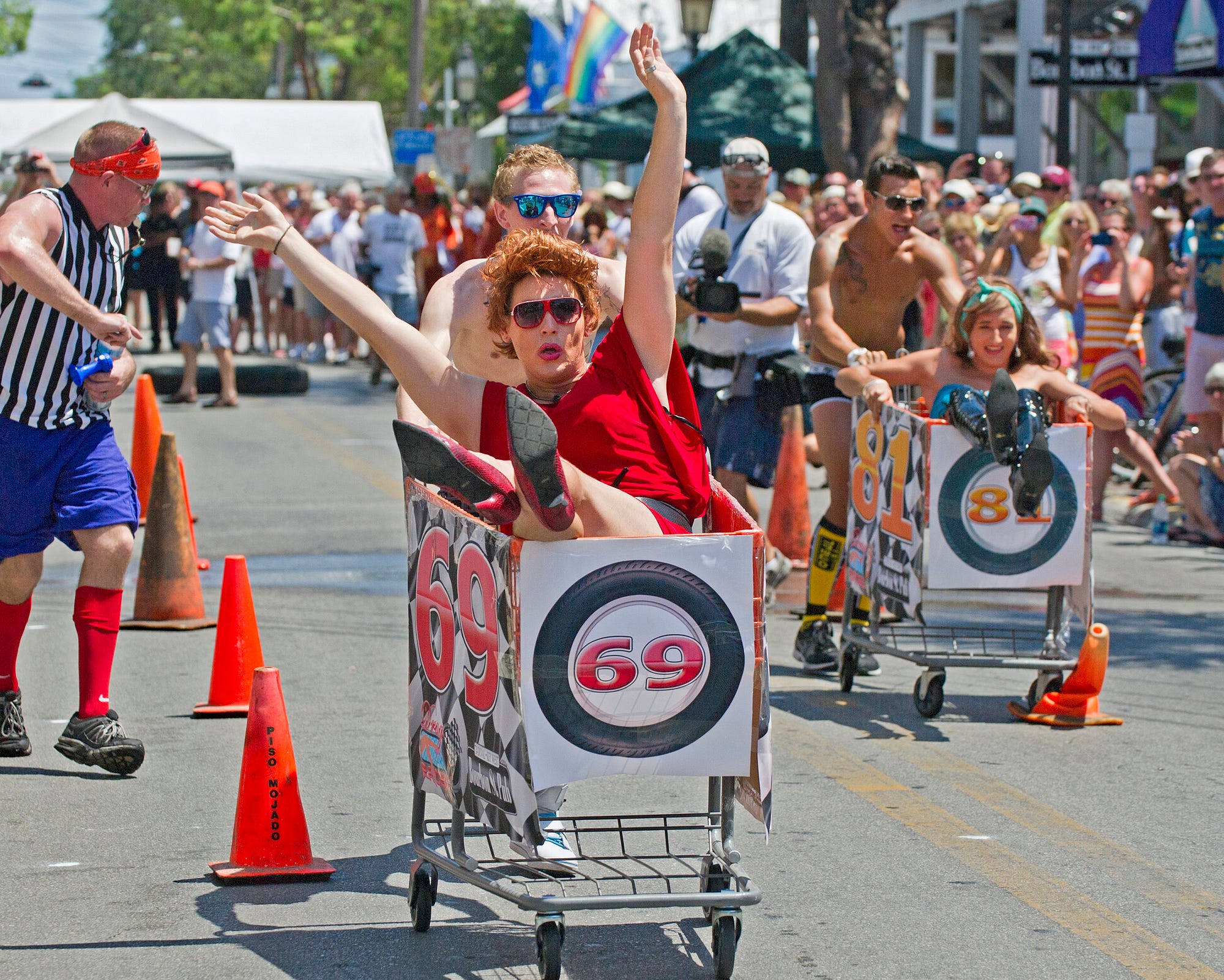
No comments:
Post a Comment